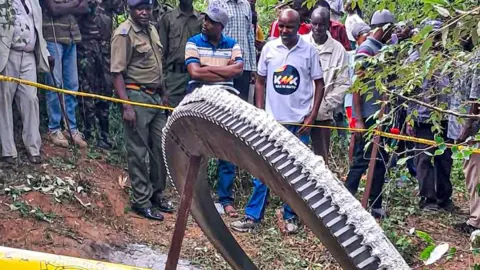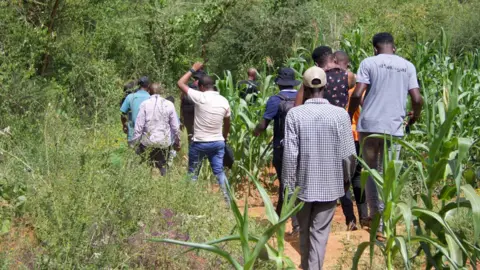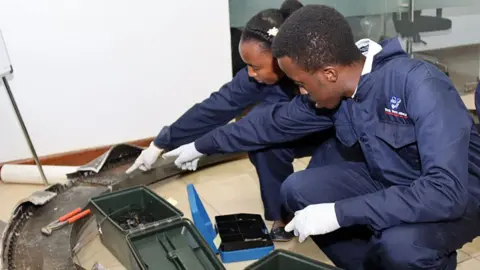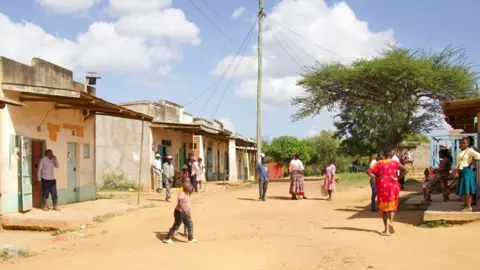 Getty Images
Getty ImagesVillagers in Kenya enjoying an afternoon with family and friends.
“It sounded like a bomb, I was shocked. I looked around, wondering if it was gunshots,” Stephen Mangoka, a 75-year-old farmer from Mukuku village in Makueni County, told the BBC.
“I looked in the sky to see if there was smoke. There was nothing.
“I ran down the road to check if there had been an accident. Also, nothing. When someone told me that something had fallen from the sky.”
In fact, a large spherical metal object fell from a dry river bed, landing on farmland – and it was hot.
“We found a large piece of metal that was very red so we had to wait for it to cool before anyone could go near it,” said Anne Kanuna, who told us she owns the land where the object fell.
The giant ring took about two hours to cool and turn gray – but it has already become a sensation as people flock to see it.
For the rest of that Monday afternoon – with some people working like it was New Year's Eve – crowds came to see the giant metal ring.
It was like selfie center, people come to pose next to it and great debate about what it could be.
Local authorities in Makueni County – which is about 115 kilometers (70 miles) southeast of the capital Nairobi – were notified.
The Kenya Space Agency (KSA) then heard about it and arranged to come the next day to investigate.
But such was the object's reputation that Mukuku villagers feared it would be stolen overnight.
Together with local officials, some of them took turns to keep watch, lighting nearby fires. They wanted to keep potential scrap dealers away and make money off the curiosity of others.
It weighs more than 500kg (1,102lb) – the same as an adult horse – and is about 2.5m (8ft) in diameter, roughly the size of a children's four-seater merry-go-round.
As daylight dawned, more visitors arrived on New Year's Eve – followed by the KSA team and the media.
 Peter Njorose/BBC
Peter Njorose/BBCMukuku had never seen such an action. When the object was removed by the KSA later that day, the buzz gave way to concern among the villagers about what was inside.
The KSA said its initial assessment indicated the object was “a separation ring” from a space launch rocket.
“These types of objects are typically designed to re-enter Earth's atmosphere or fall into uninhabited areas such as oceans,” its statement said the following day.
No one was injured when it read but some in Mukuku have started complaining that the impact of the accident has damaged nearby houses.
Christine Kionga, who lives about a kilometer away from the crash site, showed us cracks in the concrete of some of the buildings in her home compound. He said they appeared after the accident.
Other neighbors have complained that the structural integrity of their homes has also been affected – allegations that have yet to be substantiated.
Mukuku resident Benson Mutuku told the BBC, “The government needs to find the owners of these objects and get compensation for those affected by it.”
There were reports in the local media that some residents started complaining of feeling sick after being exposed to the metal rings although there was no confirmation from them when we visited – neither from the authorities nor from the KSA.
Yet Mr Mutuku said there were concerns about the long-term effects of potential space radiation.
“It is a space object and we have heard in other similar incidents that the effects of radiation have even affected future generations and there is that fear in this community.”
Although later tests conducted by the Kenya Nuclear Regulatory Authority showed that the metal ring had higher radiation levels than the area where it was found, they were not at levels harmful to humans.
 Peter Njorose/BBC
Peter Njorose/BBCEngineers at KSA, which was established in 2017 to promote, coordinate and control space-related activities in the East African country, are conducting other tests to learn more about the object.
The KSA Director General said that it was lucky that the object did not cause any significant damage when it hit the Earth.
Brigadier Hilary Kipkosgei told the BBC, “The ultimate responsibility for any damage or injury caused by that space object rests with the state into whose jurisdiction that operator may have launched the object.”
According to the Outer Space Treaty, overseen by the UN Office for Outer Space Affairs, “States shall be responsible for damage caused by their space objects”.
“[The ring] It is a common item in many rockets and many space objects so it is difficult to attribute it to a specific rocket or space object but we have leads but as I say our investigation is not conclusive,” Brigadier Kipkosgei said.
The BBC showed images of the object to the UK Space Agency to get their experts' thoughts.
“The most plausible object is the upper stage separation ring from an Ariane rocket in 2008,” said its launch director, Matt Archer.
“The satellites are fine, but the actual rocket body has arrived and is in orbit.”
Ariane was Europe's main rocket launch vehicle, helping more than 230 satellites into orbit, before it was retired in 2023.
The separation ring appears to have been orbiting Earth for 16 years before unexpectedly appearing in Mukuku.
This is not the first case of space debris in East Africa.
Just a year and a half ago, some suspicious space debris fell on several villages in western Uganda.
And a few days earlier, on January 8, there were unconfirmed reports of what was believed to be space debris glowing brightly in the sky over northern Kenya and southern Ethiopia.
 Peter Njorose/BBC
Peter Njorose/BBCAs the space industry grows, it is predicted that such incidents will become more frequent – and African governments may need to invest in ways to detect this fast-moving space junk.
NASA estimates there are more than 6,000 tons of space debris in orbit right now.
There are various assumptions about the likelihood of such litter hurting someone, But most are about one in 10,000.
Such statistics are of little comfort to the residents of Mukuku, who cannot help but wonder what damage the ring would do if it landed in the middle of the village instead of farmland.
“We need assurances from the government that this will not happen again,” Mr Mutuku said.
You may also be interested in:
 Getty Images/BBC
Getty Images/BBC